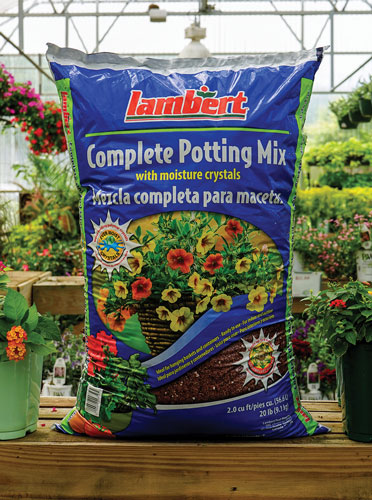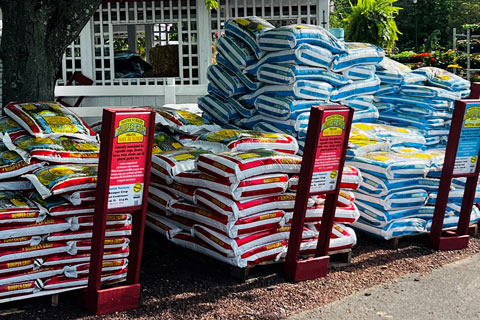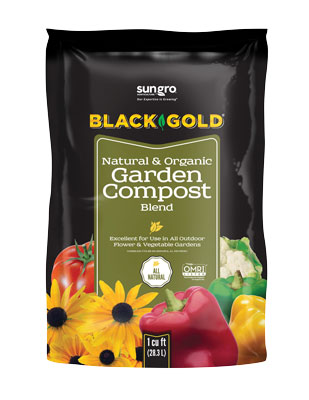10/1/2023
Key Components for Mixes
Jennifer Polanz

Potting and soil mixes now have a growing list of ingredients gracing their labels, and there are more soil amendments on retail shelves than ever as companies have developed more options for consumers. Let’s talk about the basics of what’s in those mixes and why, and then dive into some of the more unique ingredients and what they do.
Those Key Elements: Mix 101
Customers looking for potting mixes for outdoor containers need good drainage that’s somewhat lightweight. To get that, many mixes include ingredients like peat moss for water retention and perlite for drainage, said Fred Gagnon, an agronomist at Lambert Peat Moss. If there’s peat moss in the mix, then there’s usually something to offset the pH, as peat is acidic with a low pH. Limestone additions can bring that pH up to a mid-range of anywhere between 5.5 and 6.4, which is typically where most plants thrive.
Pictured: The Lambert Complete Potting Mix with Moisture Crystals has those water-holding polymers in it that retain moisture, allowing for longer periods between watering.
Oftentimes, manufacturers will include fertilizer in the mix, which will start the consumer off right with their containers. It depends on the fertilizer how long it will last, though, Fred said. For example, conventional controlled-release fertilizer lasts longer than organic.
“Organic fertilizer, because it’s not the same product (as conventional), you will have something that will release on a daily basis or weekly basis, but it will not last as long as six months,” he said, adding it would last more like six to seven weeks. That’s still a great start for consumers and it’s something a retailer can continue the message around with an add-on organic fertilizer sale.
Other Ingredients You May See
There are lots of other ingredients you can see in potting and soil mixes, and we’ll likely just scratch the surface here. The important thing is to understand what these ingredients bring to the table so when consumers ask, you can give them the details.
Sungro Horticulture’s most popular consumer brand is Black Gold, which has some of those basic ingredients we talked about already. However, depending on the mix, they might pull back on some peat and add composted or aged bark to add some weight and help with drainage and aeration, said Connie Johnson, who some of you may know from her time as the grower specialist for the Southeast region at Sungro. She’s now transitioning to the research and development team as a research scientist. She noted you may also see coir included in the list of ingredients, sometimes with peat or sometimes as a replacement.
Lots of mixes, like the Black Gold brands, include wetting agent. While that sounds like a water-retention product, it’s not—it helps the mix re-wet if it dries out completely.
“With some ingredients like peat moss, it can be hard to re-wet when it gets extremely dry, so a wetting agent will help to break that hydrophobic surface once it gets watered again,” she said.
There are water-holding polymers or crystals, though, that do help retain water to buy customers more time between waterings. Products like JRM Chemical’s Soil Moist can be sold as an amendment and added during planting. Some bagged goods manufacturers include these water-holding crystals in their potting mix, as well. For example, Sungro offers it in their Fafard Ultra Container Mix, along with an extended-release fertilizer, and Lambert has it in its Complete Potting Mix with Moisture Crystals.
 Pictured: Marrazzo’s Manor Lane in Newtown, Pennsylvania, shows the easy choice
Pictured: Marrazzo’s Manor Lane in Newtown, Pennsylvania, shows the easy choice
customers have with Bumper Crop products from Master Nursery Garden Centers: red for
in-ground Soil Builder and blue for Potting Soil.
Going back to Lambert, Fred noted they also have a component called EcoPeat Plus that’s a fibrous shredded wood fiber harvested from their peat bogs that can take the place of perlite, which helps with drainage.
I also talked to Pat Flaherty, vice president of sales for Master Nursery Garden Centers, which offers the Bumper Crop organic brand exclusively to independent garden centers. The Bumper Crop Potting Soil they offer to East Coast and Midwest retailers is made by Coast of Maine, and the West Coast products are made by E.B. Stone. They have different ingredients based on the coast, but offer the same lightweight water retention and drainage (the West Coast blend features aged fir bark, earthworm castings, bat guano, and kelp, while the East Coast blend has sphagnum peat moss, compost, perlite, lobster and crab shell meal, and kelp meal).
“They can put unique inputs into Bumper Crop soils for us,” Pat said about their providers. “What that does is it really helps the independent garden centers out there to differentiate themselves from their competition.”
Growing in Popularity
There are some components that are becoming more popular, Connie said. Those include earthworm castings, which many companies offer as a stand-alone amendment that can be used in many applications; and mycorrhizae, which can be a component in a mix or sold as a separate amendment, like Myke. This ingredient with the funny name is a beneficial fungi that creates a symbiotic relationship with the plants’ root systems to allow for greater nutrient uptake and healthier plants.
Sungro also has an amendment called RESiLIENCE, which is their trade name for a silicon amendment. It’s a beneficial nutrient that some plants will take up and use when stressed to help improve recovery from wilting.
 Both Fred and Connie said the popularity of organic products continues today, with customers looking for those in specific areas like vegetable gardening and edibles containers. To that end, Connie said they try to have as many of their aggregates as possible to serve the dual purpose of natural and organic. Fred noted they’ve seen demand from both the U.S. and Canadian market for organics, but even more so in the U.S. Locally sourced and sustainably sourced options are becoming more popular as well.
Both Fred and Connie said the popularity of organic products continues today, with customers looking for those in specific areas like vegetable gardening and edibles containers. To that end, Connie said they try to have as many of their aggregates as possible to serve the dual purpose of natural and organic. Fred noted they’ve seen demand from both the U.S. and Canadian market for organics, but even more so in the U.S. Locally sourced and sustainably sourced options are becoming more popular as well.
Pictured: The Black Gold Natural & Organic Garden Compost Blend from Sungro Horticulture includes Canadian sphagnum peat moss, compost and processed bark.
Amending the Soil
So far we’ve mainly talked about potting mixes, but consumers are also looking to fix their soils in lots of other ways, including in raised bed gardens, flower beds and large garden plots. With these situations, it’s important to ask the customer what they’re trying to accomplish. Are you building a raised bed? Are you breaking up clay or sandy soil? What’s the end goal?
Connie said if they’re amending sandy soil, peat is a better bet for retaining moisture, but compost and/or bark can work, as well. These options work for clay, too, as the goal is breaking up the dense texture. For raised beds, consumers can use a peat and perlite mix with fertilizer. Now, several companies offer a raised bed mix with the right ratios to make it easier for newer gardeners. Compost and earthworms castings can also be added for additional enriching organic material.
Pat noted that they try to make it easy for retailers and customers. They have the Bumper Crop Potting Soil for containers (a blue bag), and the Soil Builder (a red bag) for in the ground. On the West Coast there’s also the Soil Conditioner (a black bag) that helps break up clay soil. The colors keep it easy to remember.
“That way they’re selling the correct product,” he said. “There are so many new employees, everybody’s understaffed. They love it because everywhere but the West Coast there’s really two options: in-ground red and containers blue.” GP